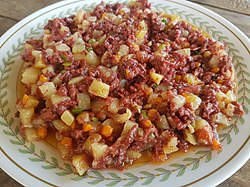The examples and perspective in this article may not represent a worldwide view of the subject.(March 2022) |
 Cooked corned beef | |
| Alternative names | Salt beef, bully beef (if canned) |
|---|---|
| Main ingredients | Beef, salt, nitrates |
| Variations | Adding sugar and spices |
Corned beef, called salted beef in some Commonwealth countries, is a salt-cured piece of beef. The term comes from the treatment of the meat with large-grained rock salt, also called "corns" of salt. Sometimes, sugar and spices are added to corned beef recipes. Corned beef is featured as an ingredient in many cuisines.
Contents
- History
- Pre-20th century
- 20th century to present
- Nutrition and health effects
- Cultural associations
- Regions
- North America
- Europe
- Middle East
- Oceania
- East Asia
- Southeast Asia
- See also
- Song references
- References
Most recipes include nitrates, which convert the natural myoglobin in beef to nitrosomyoglobin, giving it a pink color. Nitrates and nitrites reduce the risk of dangerous botulism during curing by inhibiting the growth of Clostridium botulinum bacteria spores, [1] but react with amines in beef to form compounds that cause cancer. [2] Beef cured without nitrates or nitrites has a gray color and is sometimes called "New England corned beef". [3]
Tinned corned beef, alongside salt pork and hardtack, was a standard ration for many militaries and navies from the 17th through the early 20th centuries, including World War I and World War II, during which fresh meat was rationed. [4] Corned beef remains popular worldwide as an ingredient in a variety of regional dishes and as a common part in modern field rations of various armed forces around the world.










